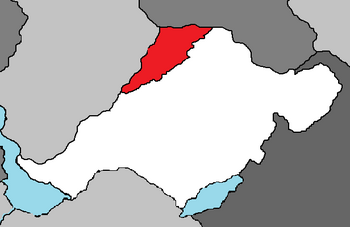East Chanchajilla: Difference between revisions
No edit summary |
|||
| Line 3: | Line 3: | ||
|conventional_long_name = Republic of Chanchajilla | |conventional_long_name = Republic of Chanchajilla | ||
|common_name = East Chanchajilla | |common_name = East Chanchajilla | ||
|image_flag = | |image_flag = EastChanchajillaFlag.png | ||
|alt_flag = | |alt_flag = | ||
|national_motto = | |national_motto = | ||
Revision as of 17:15, 1 September 2020
Republic of Chanchajilla | |
|---|---|
|
Flag | |
 East Chanchajilla (white) and the State of Turania (red), which is contested with West Chanchajilla and Paraboca | |
| Capital | Vilanja |
| Recognised national languages | Spanish, English |
| Government | Federal Republic |
• President | Gideon Boer |
| Establishment | |
• Unification of Chanchajilla | 1450 |
• Chanchajilla breaks apart | 1932 |
• Republic of Chanchajilla | 1951 |
| Population | |
• 2020 estimate | 47,800,000 |
| Currency | Chancu Dimo |
| Date format | mm-dd-yyyy |
East Chanchajilla, or as it is less commonly referred to as the Republic of Chanchajilla is a nation located on the continent of Euronia in the Coalition of Crown Albatross. It is landlocked and bordered by Zamastan to the south, Paraboca to the north, West Chanchajilla to the west, and Avergnon in the east. The west and east had been unified as Greater Chanchajilla from their respective kingdoms since 1450, although a brutal occupation and resulting violent Parabocan War eventually eroded the social and governmental states of the nation. The separation of Chanchajilla and the ensuing Chanchajillan Civil War in 1932-44 resulted in two separate nations; east and west. East Chanchajilla, which remained a capitalist-centered economy with more political freedoms than their neighbors to the west, gained significant aid from Zamastan, who provided packages that built their military, infrastructure, and economics.
East Chanchajilla is considered developing, and has a semi-industrialised economy with a well-integrated agriculture sector and a growing services sector. It is ranked among the emerging economies of the world, and is backed by one of the world's largest and fastest-growing middle class. The country continues to face challenging problems, including overpopulation, terrorism, poverty, illiteracy, and corruption. East and West have also had multiple violent and sporadic conflicts between on their border in the past century, including the South Turania Offensive.
History
Early Age
Unification of Kingdoms
Parabocan Occupation
The Parabocan War
Separation and Civil War
Republic
In 1949-50, Drambenburgian airraids on East Chanchajillan military supply storages, provoked by the rampant escalation of the World War ongoing in neighboring Avergnon, prompted the nation to offer refugee status to thousands of Avergnonians. The country eventually joined the war, allowing Zamastanian troops to use their territory as a staging area to recapture Avergnon, and often times fighing alongside them in massive battles. East Chanchajilla reformed into a republic following their entrance to the war and in the midst of the conflict, electing their first ever President, Biel Morata, in 1951. The World War concluded in 1954 with the surrender of Drambenburg and the Dominion of the Sanguine Church, and East Chanchajilla rapidly began to modernize and flourish with a more freed up capitalist styled economy and a more open system of government. Aid from countries like Zamastan and Emmiria flowed into the country as well, further propelling their prospects.
